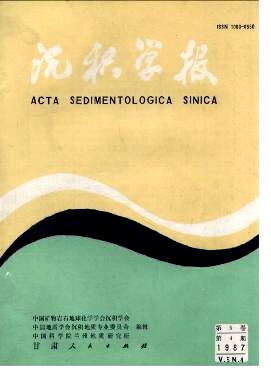DIOCTAHEDRAL HYDROMICA MINERALS AND THEIR THERMAL ANALYSIS
- Publish Date: 1987-12-10
Abstract: These hydromica minerals described in this paper include well-known dioctahedral 10A sericite, hydromuscovite, illite and micalike clay minerals, twenty major samples from Inner Mongolia, Hebei, Shanxi, Jiangsu, Zhejiang, Jiangxi and Hubei have been studied by XRD, DTA, TG and IR techniques and some detail results of their thermal properties have been presented in this text. At the same time, a few of them have also been treated with chemical and eletron microscope analysis. They are nonexpansible, pure or essentially pure and come from weathered environment, sedimentary rocks as well as metamorphic rocks respectivly. The hydromica samples have been distinguished into 2M1, 1M, 1Md, 2M1 + 1M polytypes. Besides common reflection, in XRD patterns the 2M1 polytype minerals are characterized by 3.87 A( W),3.74A(W-m),3.49 A(m), 3.20 A(m), 2.86 A(W-m), 2.79 A(W-m),and 2.13 A(W) etc. refraction, but the 1M polytype by 4.32 A(W-m), 3.65 A(m-W), 3.06 A(m-s), 2.92 A(W) and 2.68 A(W-m ) etc. The former mostly occur in the altered rocks at medium-high temperature zone and the later in sedimentary or altered rocks of low-medium temperature, The XRD reflection for 1Md minerals is rare and weaker. These 1Md minerals usually present in weathered and sedimentary products. The DTA curves of the hydromica minerals generally show two endothermic peaks, the first low temperature peak at about 100℃ is of moving off absorbed and interlayer water and correspondingly loses 0.2-4% weight the second medium-temperature peak at 500-900℃ or above is attributed to dehydroxylation, appearing with 4.6-6.2% weight loss. On these DTA curves, generally speaking, the higher-temperature thermal effect that represents structural desintegration(break) and phase transformation does not clearly appear. The IR and XRD graphs of the samples, heated at 30℃/min to 800℃ or900℃ till lossing hydroxyl, show that their basic structure still remains stable, only as heated to about 1100℃ or 1200℃ , do they change into Al-rich andalusite or spinel. On a routine identification of hydromica minerals, the following is suggested; it can be known "sericite" as whose XRD pattern approximates that of muscovite, the temperature of dehydroxyl peak in the DTA curve is above 700℃ and the mineral apperance is aphanitic and microscalyj it is in terms of " hydromuscovite " or "hydromica" that the(ool) refraction of XRD pattern is broader and weaker and the temperature of dehydroxyl peak between 600℃ and 700℃ if the temperature below 600℃, especially below 550℃, it is suitable to call the samples "illite" for it usually is epigene and its crystallization is poor, sometimes with expansible layers.
| Citation: | Yang Yaxiu, Lu Danong, Su Zhaobing. DIOCTAHEDRAL HYDROMICA MINERALS AND THEIR THERMAL ANALYSIS[J]. Acta Sedimentologica Sinica, 1987, 5(4): 31-43. |






 DownLoad:
DownLoad: